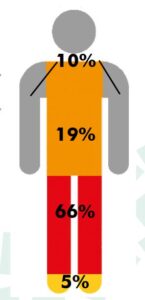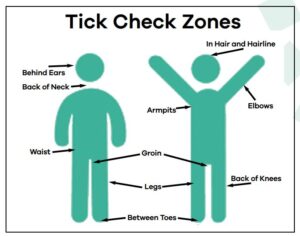Last year it was confirmed that Tick Born Encephalitis (TBE) is now present in the tick population in the UK.
Awareness of ticks and the diseases they can transmit has increased in the recent past with several well known people making their diagnosis of Lyme’s Disease publicly known.
Last year it was confirmed that Tick Born Encephalitis (TBE) is now present in the tick population in the UK
The increase in tick numbers and their activity over the past few years means more of us will come across them in our work than before. It is difficult in our daily work to avoid the types of habitats where ticks live and thrive, so we must remain alert to the risk and reduce the likelihood of a bite where we can. You must do a tick check at the end of each day out on site, the graphic below shows you the hot spots for tick bites.
Most common areas on the body to find ticks
• 10% Arms
• 19% Torso
• 66% Legs
• 5% Feet/Ankles
We can reduce the likelihood of a tick bite by following the guidance in Tilhill’s Guidance Note 83 (GN/83). GN83 is a comprehensive guide and gives more details on steps to take to reduce your risk. Your best defence if you do have a tick bite is to quickly identify any ticks that are attached and safely remove using a proper tick removal tool. GN83 is supported by two further documents, ‘Top Tips for Ticks’ and a ‘Myth Buster’ guide.
These are both informative and help to explain a little more about ticks, their habits and lives.





